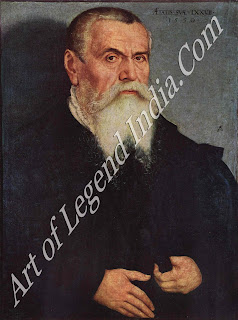 German Artist Lucas Cranach
German Artist Lucas Cranach
From
obscure beginnings Lucas Cranach became a celebrated and wealthy painter,
second only to Darer in the German Renaissance. For almost 50 years he served
the Electors of Saxony at their court at Wittenberg, and owed much of his
success to their enlightened patronage. He controlled a large studio which
produced a huge output of beautifully finished pictures, many painted by his
two sons.
Always
in contact with scholars, Cranach played a leading part in bringing the ideas
and artistic language of the Italian Renaissance to Germany, and from around
1515 was also the official painter for the Protestant cause. Yet his work never
simply expressed Reformation or Renaissance ideas. 1-16 style was his own
provincial because of his geographic isolation and personal because of his
unique vision of the world.
THE LUCAS CRANACH'S LIFE
A Busy and Successful Life
Cranach
rose from provincial obscurity to become court painter to the Electors of
Saxony. But his association with leading figures of the Reformation did not
prevent him enjoying wealth and prestige.
Lucas
Cranach took his name from the town of Kronach, where he was born in 1472.
Kronach was an unimportant town in Upper Franconia, a part of the Holy Roman
Empire ruled by the Church through the Diocese of Bamburg. Although only 15
miles east of Coburg, ruled by the Elector of Saxony, it fell into the cultural
orbit of Nuremberg, an Imperial city some 50 miles to the south.
Almost
nothing is known of Lucas' childhood or early training. His father was himself
a painter, referred to in documents as Hans Maier, meaning 'Hans the Painter'
and Lucas also took this surname in his early years.
Key Dates
1472 born in Kronach, upper
Franconia c.1501 arrives in Vienna
1505 enters the service of
Frederick the Wise and goes to Wittenberg with him
1508 is granted a personal
coat of arms by the Elector and visits the Netherlands to paint portrait of the
future Charles V
C.1511-13 marries - Barbara
Brengbier
1525 sets up a printing firm
1537 elected burgomaster. Si
Hans dies in Italy
1540 wife dies
1550 goes to Augsburg
1552 goes to Weimar
1553 dies in Weimar
TRAINED BY HIS FATHER
Hans
was obviously successful, for he lived in a substantial house in Kronach's
market square. None of his output has been identified, but we can presume that
he worked in woodcut as well as producing devotional works for local churches
and houses, and perhaps also carried out mural decorations. Lucas would have
assisted and taken his training from him.
Lucas
probably remained in his father's workshop, off and on, until around 1498, when
he was 26. An unsubstantiated account suggests he went on pilgrimage to the
Holy Land in 1493 in the entourage of Elector Frederick of Saxony and Duke
Christopher of Bavaria. In this case, he would have visited Venice and Rhodes
en route, but there is no evidence in his later work of his having seen foreign
landscapes. More certain are that he was in Vienna from around 1501. On the way
there he would have passed through Nuremberg, where he may have encountered the
work of Albrecht Durer, one year his senior.
Although
he was by now 30 years of age, no works by Cranach before this time have been
identified. The first signed and dated works in Vienna show a mature talent, and
by 1503 he was producing woodcut designs for the city's leading printer. These
show a clear influence from Durer's work in this medium, although Cranach
invested them with a nervous intensity all his own. Vienna was far more
advanced intellectually than Franconia, and Cranach soon joined the circle of humanist
scholars gathered around the university who were fired by Renaissance ideas
emanating from Italy. Among his finest early works are portraits of Johannes
Cuspinian, rector of the university, and his wife.
IN THE SERVICE OF THE ELECTOR
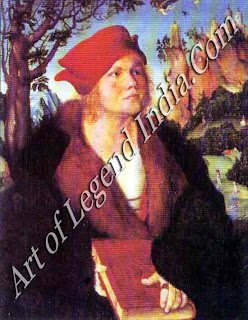 In
about 1504, Cranach's growing reputation as a painter and his association with
progressive intellectuals from the university led to him being taken into the
service of Frederick the Wise, Elector of Saxony. The Elector probably came
across Cranach through the court in Vienna, where we can assume he was already
carrying out work for the Emperor. In 1505, Cranach returned with Frederick to
Wittenberg. This town on the river Elbe had been developed during the 15th century
as the capital of Saxony, a region consisting largely of poor land, with
scattered communities surrounded by expanses of heath and forest.
In
about 1504, Cranach's growing reputation as a painter and his association with
progressive intellectuals from the university led to him being taken into the
service of Frederick the Wise, Elector of Saxony. The Elector probably came
across Cranach through the court in Vienna, where we can assume he was already
carrying out work for the Emperor. In 1505, Cranach returned with Frederick to
Wittenberg. This town on the river Elbe had been developed during the 15th century
as the capital of Saxony, a region consisting largely of poor land, with
scattered communities surrounded by expanses of heath and forest.
As part
of the development and modernization of his domains, made wealthy by mining
activities, Frederick the Wise founded a university at Wittenberg in 1502 and
began the process of attracting influential scholars. In a sense, Cranach was
one of these; his appointment intended to contribute to enhancing the prestige
of the Elector as a rich and cultured ruler, inhabiting a magnificent palace
decorated with fine works of art. This patronage gave Cranach status and
stability and for almost 50 years he lived and worked in Wittenberg, producing
hundreds of pictures and assuming an ever grander lifestyle. At some stage he
married Barbara Brengbier, who came from Gotha and was five years his junior.
They had five children, including two sons who worked for many years in their
father's workshop.
The
first picture known to have been painted by Cranach in Wittenberg is the
Martyrdom of St Catharine (p.1289), which repeats a subject already painted
during the Vienna period. As well as major commissions of this type, Cranach
began the series of portraits of the Elector, his family and courtiers that
would continue throughout the artist's entire career. In addition, he had
responsibility for the decoration of the Elector's new buildings. He appears to
have been an adaptable and diligent craftsman, ably controlling his assistants
and thus capable of producing a large output of well-finished pictures. Other
duties included the design of court dress and emblems for the armour of the
royal guard.
 From
the limited evidence, we can see that Cranach enjoyed huge success in
Wittenberg. In 1508, Frederick granted him a coat of arms a winged and crowned
serpent with a ring in its mouth. In the same year, he was sent by the Elector
to the Netherlands where he painted the portrait of the 8-year-old Charles,
future Holy Roman Emperor a great honour. According to a story, while in the
Netherlands, Cranach drew the likeness of Emperor Maximilian on a wall, .5,,
remembered from Vienna, much to the amazement of those present who had seen the
:2 Emperor in the flesh.
From
the limited evidence, we can see that Cranach enjoyed huge success in
Wittenberg. In 1508, Frederick granted him a coat of arms a winged and crowned
serpent with a ring in its mouth. In the same year, he was sent by the Elector
to the Netherlands where he painted the portrait of the 8-year-old Charles,
future Holy Roman Emperor a great honour. According to a story, while in the
Netherlands, Cranach drew the likeness of Emperor Maximilian on a wall, .5,,
remembered from Vienna, much to the amazement of those present who had seen the
:2 Emperor in the flesh.
From
about 1508, Cranach painted an increasing number of subjects based on classical
mythology, showing the importance of humanist ideas at the court. However, more
far-reaching developments ones that were irrevocably to change the whole
Christian world began to take place at Wittenberg. In 1508 Martin Luther
arrived at the university to lecture on ethics. His radical ideas aroused great
enthusiasm in Wittenberg and controversy throughout Germany. In 1517 he fixed
his famous 95 Theses to the door of Wittenberg Castle Church, vigorously
attacking the corruption of the Church, and four years later the Pope
excommunicated him. Throughout these turbulent events Luther enjoyed the
protection of Elector Frederick the Wise, who at this dangerous juncture took
him into hiding at Wartburg Castle where he began his translation of the Bible
into German from Greek and Hebrew texts. Meanwhile Luther's supporters in
Wittenberg, now led by Philip Melanchthon, began to put his ideas into
practice.
CHAMPION OF THE REFORMATION
 Cranach
was undoubtedly involved in these events. He became friends with Luther and
painted his portrait many times. He also produced the reformer's likeness in
engraved and woodblock form for wide dissemination as part of the growing flood
of Protestant propaganda. In supporting Luther, Cranach was entirely in step
with the Wittenberg court, with the Elector of Saxony leading a movement of
German princes to assert their independence from the Roman Church and to a
lesser extent the Empire.
Cranach
was undoubtedly involved in these events. He became friends with Luther and
painted his portrait many times. He also produced the reformer's likeness in
engraved and woodblock form for wide dissemination as part of the growing flood
of Protestant propaganda. In supporting Luther, Cranach was entirely in step
with the Wittenberg court, with the Elector of Saxony leading a movement of
German princes to assert their independence from the Roman Church and to a
lesser extent the Empire.
Cranach's
friendship with Luther is difficult to assess, but a few letters survive in
which Luther wished Cranach's family well in intimate terms, suggesting they
were quite close. But Luther's teaching did not radically alter the direction
of the 1285 painter's work. If anything, the number of sacred altarpieces was
increased, although with a greater concentration on scenes from the life of
Christ rather than the legends of the saints. Luther's religion was not
iconoclastic or egalitarian; his pious form of Christianity saw no objection to
religious imagery and he advocated vigorous punishment for the rebels in the
Peasant's War of 1524-25. He remained faithful to the Elector, like Cranach.
Curiously to modern eyes and this demonstrates the complexity of the conflict Cranach
felt free to continue to produce work for Catholic patrons, including Cardinal
Albrecht of Brandenburg, who also patronized Grunewald.
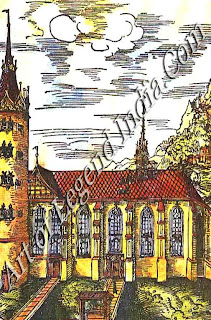
Against
this background Cranach went from strength to strength. As early as 1512 he
owned several properties and in 1520 he set up a pharmacy with the Elector's
personal physician Martin Polich as partner. He continued to acquire property,
some of it away from the fashionable market square where he lived in a large
house, and received considerable sums in rent. Indeed, he was obviously a
successful businessman, perhaps making more money in other ways than he did as
a painter.
A BUSY WORKSHOP
Cranach
was now the master of a thriving workshop producing portraits, religious
subjects and mythological scenes (which were often coyly erotic) for many
important patrons in addition to the Elector and destined for churches and
palaces all over Germany. There is evidence that he had a wine-selling business
and he certainly cashed in on the boom that the Protestant Reformation brought
to Wittenburg publishing.
In
1525, John Frederick I became Elector and granted Cranach, the court painter,
the right to set up a printing firm with Christian airing, the court jeweller.
Enthusiasm for the Protestant writings of Luther and others ensured success and
very quickly Wittenberg took over from Leipzig as the leading publishing centre
in the area. Cranach and Daring financed the publishing of the first part of
Luther's Bible, an enormous undertaking, and in 1525 the partners succeeded in driving
a rival printer out of Wittenberg. By 1533, the firm was less successful and
Cranach, now sole owner, sold it. In 1528, according to the tax returns,
Cranach was one of Wittenberg's wealthiest inhabitants, with property of a
declared value of 4000 gilders. An indication of the splendour of his lifestyle
is that when in 1523 the exiled king of Denmark, Christian II, came to stay at
Wittenberg, he was housed in one of Cranach's properties.
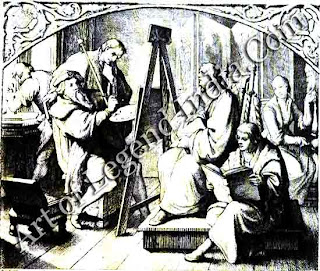 The
workshop, which must have employed numerous assistants including Cranach's
sons, was efficiently run and had a vast output. In 1533, it accepted a
commission for no fewer than 60 pairs of portraits of the two previous
Electors. In 1537, Cranach was elected burgomaster or mayor of Wittenberg, a
post he held again in 1540 and 1543. In 1537 he sent his eldest son Hans on a
study tour of Italy. The young man was evidently a gifted painter whose work
cannot really be distinguished from that of his father, but unfortunately he
died while in Bologna.
The
workshop, which must have employed numerous assistants including Cranach's
sons, was efficiently run and had a vast output. In 1533, it accepted a
commission for no fewer than 60 pairs of portraits of the two previous
Electors. In 1537, Cranach was elected burgomaster or mayor of Wittenberg, a
post he held again in 1540 and 1543. In 1537 he sent his eldest son Hans on a
study tour of Italy. The young man was evidently a gifted painter whose work
cannot really be distinguished from that of his father, but unfortunately he
died while in Bologna.
JOURNEYS TO NUREMBERG
Cranach
seems to have travelled occasionally in the 1530s himself, visiting Nuremberg
for the third Imperial Diet and again in 1539 to escape a plague that was
gripping Wittenberg. Documents tell that Cranach's wife died in 1540, but we do
not know the circumstances. Cranach was now 68, but from the evidence of his
pictures clearly still in full command of his powers. His younger son Lucas
probably ran the studio on a day to day basis, but the father took
responsibility for the most important commissions.
In the
1540s the struggle between the Catholic Emperor and the Protestant elector
intensified and in 1544 Wittenberg was besieged. Remarkably, Cranach was
summoned from the town on a safe conduct to see the Emperor, who wished to know
who painted a Cranach picture in his possession the father or one of his sons.
In 1547, John Frederick was defeated at the battle of Muhlberg and was taken in
captivity to Augsburg, where he was joined by Cranach. Peace was made and, in
1552, Cranach went with John Frederick, now a prince of the empire, to Weimar.
There he stayed in the house of one of his daughters, still working off and on,
until his death on October 16 1553.
Writer
– Marshall Cavendish
 German Artist Lucas Cranach
German Artist Lucas Cranach In
about 1504, Cranach's growing reputation as a painter and his association with
progressive intellectuals from the university led to him being taken into the
service of Frederick the Wise, Elector of Saxony. The Elector probably came
across Cranach through the court in Vienna, where we can assume he was already
carrying out work for the Emperor. In 1505, Cranach returned with Frederick to
Wittenberg. This town on the river Elbe had been developed during the 15th century
as the capital of Saxony, a region consisting largely of poor land, with
scattered communities surrounded by expanses of heath and forest.
In
about 1504, Cranach's growing reputation as a painter and his association with
progressive intellectuals from the university led to him being taken into the
service of Frederick the Wise, Elector of Saxony. The Elector probably came
across Cranach through the court in Vienna, where we can assume he was already
carrying out work for the Emperor. In 1505, Cranach returned with Frederick to
Wittenberg. This town on the river Elbe had been developed during the 15th century
as the capital of Saxony, a region consisting largely of poor land, with
scattered communities surrounded by expanses of heath and forest.  From
the limited evidence, we can see that Cranach enjoyed huge success in
Wittenberg. In 1508, Frederick granted him a coat of arms a winged and crowned
serpent with a ring in its mouth. In the same year, he was sent by the Elector
to the Netherlands where he painted the portrait of the 8-year-old Charles,
future Holy Roman Emperor a great honour. According to a story, while in the
Netherlands, Cranach drew the likeness of Emperor Maximilian on a wall, .5,,
remembered from Vienna, much to the amazement of those present who had seen the
:2 Emperor in the flesh.
From
the limited evidence, we can see that Cranach enjoyed huge success in
Wittenberg. In 1508, Frederick granted him a coat of arms a winged and crowned
serpent with a ring in its mouth. In the same year, he was sent by the Elector
to the Netherlands where he painted the portrait of the 8-year-old Charles,
future Holy Roman Emperor a great honour. According to a story, while in the
Netherlands, Cranach drew the likeness of Emperor Maximilian on a wall, .5,,
remembered from Vienna, much to the amazement of those present who had seen the
:2 Emperor in the flesh.  Cranach
was undoubtedly involved in these events. He became friends with Luther and
painted his portrait many times. He also produced the reformer's likeness in
engraved and woodblock form for wide dissemination as part of the growing flood
of Protestant propaganda. In supporting Luther, Cranach was entirely in step
with the Wittenberg court, with the Elector of Saxony leading a movement of
German princes to assert their independence from the Roman Church and to a
lesser extent the Empire.
Cranach
was undoubtedly involved in these events. He became friends with Luther and
painted his portrait many times. He also produced the reformer's likeness in
engraved and woodblock form for wide dissemination as part of the growing flood
of Protestant propaganda. In supporting Luther, Cranach was entirely in step
with the Wittenberg court, with the Elector of Saxony leading a movement of
German princes to assert their independence from the Roman Church and to a
lesser extent the Empire.  The
workshop, which must have employed numerous assistants including Cranach's
sons, was efficiently run and had a vast output. In 1533, it accepted a
commission for no fewer than 60 pairs of portraits of the two previous
Electors. In 1537, Cranach was elected burgomaster or mayor of Wittenberg, a
post he held again in 1540 and 1543. In 1537 he sent his eldest son Hans on a
study tour of Italy. The young man was evidently a gifted painter whose work
cannot really be distinguished from that of his father, but unfortunately he
died while in Bologna.
The
workshop, which must have employed numerous assistants including Cranach's
sons, was efficiently run and had a vast output. In 1533, it accepted a
commission for no fewer than 60 pairs of portraits of the two previous
Electors. In 1537, Cranach was elected burgomaster or mayor of Wittenberg, a
post he held again in 1540 and 1543. In 1537 he sent his eldest son Hans on a
study tour of Italy. The young man was evidently a gifted painter whose work
cannot really be distinguished from that of his father, but unfortunately he
died while in Bologna. 

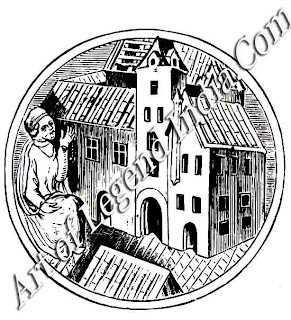











0 Response to "German Great Artist Lucas Cranach Successful Life"
Post a Comment